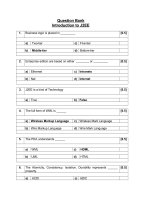Unixintro- Introduction to Unix- P1
Bạn đang xem bản rút gọn của tài liệu. Xem và tải ngay bản đầy đủ của tài liệu tại đây (104.38 KB, 60 trang )
Introduction to Unix
Rob Funk
<>
University Technology Services
Workstation Support
/>University Technology Services
Course Objectives
• basic background in Unix structure
• knowledge of getting started
• directory navigation and control
• file maintenance and display commands
• shells
• Unix features
• text processing
University Technology Services
Course Objectives
Useful commands
• working with files
• system resources
• printing
• vi editor
University Technology Services
In the Introduction to UNIX document
3
• shell programming
• Unix command summary tables
• short Unix bibliography (also see web site)
We will not, however, be covering these topics in the lecture.
Numbers on slides indicate page number in book.
University Technology Services
History of Unix
7–8
1960s multics project (MIT, GE, AT&T)
1970s AT&T Bell Labs
1970s/80s UC Berkeley
1980s DOS imitated many Unix ideas
Commercial Unix fragmentation
GNU Project
1990s Linux
now Unix is widespread and available from many
sources, both free and commercial
University Technology Services
Unix Systems
7–8
SunOS/Solaris Sun Microsystems
Digital Unix (Tru64) Digital/Compaq
HP-UX Hewlett Packard
Irix SGI
UNICOS Cray
NetBSD, FreeBSD UC Berkeley / the Net
Linux Linus Torvalds / the Net
University Technology Services
Unix Philosophy
• Multiuser / Multitasking
• Toolbox approach
• Flexibility / Freedom
• Conciseness
• Everything is a file
• File system has places, processes have life
• Designed by programmers for programmers
University Technology Services
Unix Structure
The Operating System
9–10
Programs
Kernel
Hardware
System Calls
University Technology Services
The File System
11–12
/
bin
sh date csh
etc
passwd group
lib
libc.so
usr
bin man local
bin man src
dev
ttya null
tmp home
frank lindadb
mail bin src
rfunk
University Technology Services
Unix Programs
13
• Shell is the command line interpreter
• Shell is just another program
A program or command
• interacts with the kernel
• may be any of:
– built-in shell command
– interpreted script
– compiled object code file
University Technology Services
Any Questions?
University Technology Services
Getting Started — Logging In
14
• Login and password prompt to log in
• login is user’s unique name
• password is changeable; known only to user, not to
system staff
• Unix is case sensitive
• issued login and password (usually in lower case)
University Technology Services
Terminal Type
14
• Default is often to prompt the user
• e.g. vt100, xterm or sun
• To reset:
•
setenv TERM
terminaltype (C-shell)
• may need to
unsetenv TERMCAP
•
TERM=
terminaltype
; export TERM
(Bourne shell)
University Technology Services
Passwords
15
Do:
• make sure nobody is looking over your shoulder when
you are entering your password.
• change your password often
• choose a password you can remember
• use eight characters, more on some systems
• use a mixture of character types – include punctuation
and other symbols
University Technology Services
Passwords
15
Don’t:
• use a word (or words) in any language
• use a proper name
• use information in your wallet
• use information commonly known about you
• use control characters
• write your password anywhere
• EVER give your password to anybody
University Technology Services
Passwords
15
Your password is your account security:
• To change your password, use the passwd command
• Change your initial password immediately
University Technology Services
Exiting
15
ˆC interrupt
ˆD can log a user off; frequently disabled
logout leave the system
exit leave the shell
University Technology Services
Unix Command Line Structure
16
A command is a program that tells the Unix system to do
something. It has the form:
command options arguments
• “Whitespace” separates parts of the command line
• An argument indicates on what the command is to
perform its action
• An option modifies the command, usually starts with “-”
University Technology Services
Unix Command Line Structure
16
• Not all Unix commands will follow the same standards
• Options and syntax for a command are listed in the
“man page” for the command
University Technology Services
Getting Help
19
man: On-Line manual
%
man command
%
man -k keyword
University Technology Services
Control Keys
17
Perform special functions
ˆS pause display
ˆQ restart display
ˆC cancel operation
ˆU cancel line
ˆD signal end of file
ˆV treat following control character as normal
character
University Technology Services
stty - Terminal Control
17–18
• reports or sets terminal control options
• configures aspects of I/O control
• syntax:
stty attribute value
• example:
stty erase ˆH
University Technology Services
Directory Navigation and Control Commands
20–22
pwd print working directory
cd change working directory
(“go to” directory)
mkdir make a directory
rmdir remove directory
University Technology Services
List directory contents
23–24
ls [options] [argument]
-a list all files
-d list directory itself, not contents
-l long listing (lists mode, link info, owner, size,
last modification
-g unix group (requires -l option)
University Technology Services
List directory contents
23–24
Each line (when using -l option of ls) includes the following:
• type field (first character)
• access permissions (characters 2–10):
– first 3: user/owner
– second 3: assigned unix group
– last 3: others
University Technology Services









